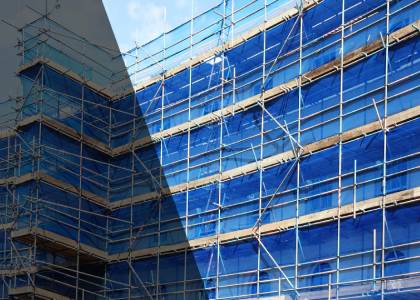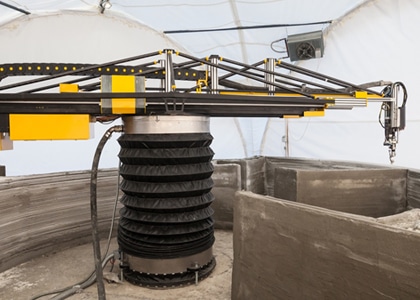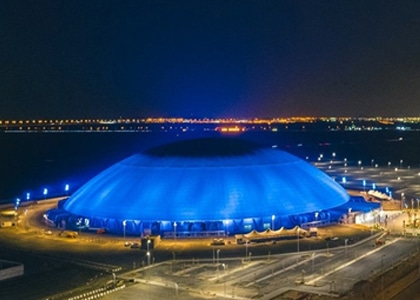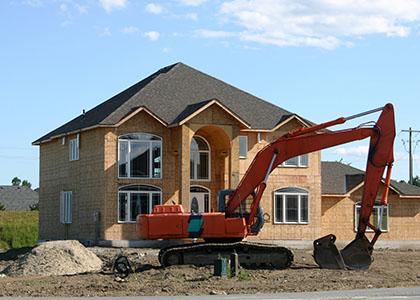Home / Blog / 10 common construction site hazards that you need to be aware of
SUMMARY
The construction industry is well known for being one of the most dangerous worldwide. It is labor-intensive and requires the movement of materials and machinery within a confined area, leading to a high level of safety hazards.
In Saudi Arabia especially, the construction industry is one of the major contributors to work-related accidents. The record of safety measures within the industry is poor, where the private sector, specifically small- to medium-sized projects seem to be the primary source of site-related injuries.
As the industry winds down on a year where a global pandemic has forced more discourse on worker and site safety, construction companies are advised to institute measures where they prioritize wellbeing for all employees working on a project.
This article brings to your awareness ten areas of weakness across construction sites that can lead to accidents, so businesses like yours can mitigate future risks that could cost you both time and money.
INDEX
- Multiple moving objects
- Hazards from slips, trips, and falls
- Noise
- Working at height
- Hand Arm Vibration Syndrome
- Material and Manual Handling
- Collapsing Trenches
- Asbestos
- Electricity
- Airborne fibers and materials
10 COMMON CONSTRUCTION SITE HAZARDS THAT YOU NEED TO BE AWARE OF
Construction sites are the sum of many moving parts, where workers are often required to use large tools, pieces of machinery and work at heights and in environments where hazardous materials are present. As Saudi construction has some of the highest accident rates in the region, it has been the subject of much research. Studies conducted across projects have helped identify five broad aspects of on-site areas where accidents can occur. These are:
- General conditions on a construction site
- Workers’ PPE
- Work on heights
- Machinery use
- Excavation areas and trenches
Within these specialized areas, some of the common construction hazards include injury and accidents from:
- Moving objects
- Slips, trips, and falls
- Noise
- Working at height
- Hand-arm vibration syndrome
- Material and manual handling
- Collapsing trenches
- Asbestos
- Electricity
- Airborne fibers and materials
- Multiple moving objects

On account of the many simultaneous processes underway on a construction site, accidents can occur if workers are not mindful. Sites are ever-changing environments, where risk rises in proportion to the stage of work underway. Moving objects like overhead lifting equipment, supply vehicles, and diggers are especially susceptible to accidents as they are usually operating on uneven terrain.
Some ways you can mitigate risks on your work site is by ensuring:
- Workers avoid working close to moving objects.
- Employees and laborers are vigilant of their surroundings, especially if the object does not have lights or beepers.
- Wear personal protective equipment (PPE), such as a high visibility jacket, to ensure they are seen.
- Hazard from slips, trips, and falls

The onus of responsibility falls on you as company owner and management to ensure that workers can move around safely. While slips, trips, and falls can happen in almost any environment, as construction sites often have uneven terrain, buildings at various stages of completion, and unused materials in different areas, they have a higher rate of accidents.
Studies indicate that several thousand construction workers are injured every year following a slip or trip and that most of these could be avoided by effectively managing signage and scaffolding around working areas and access routes, such as stairwells and footpaths. Areas of risk need to be reported and addressed immediately to reduce the chances of injury.
The following are some easy tips that you can apply onsite to reduce injury from slips and trips:
- Uneven surfaces: Uneven surfaces on the ground need to be clearly marked and highlighted. Above ground, uneven surfaces need to be secured with the right kind of formwork support and repeatedly checked to ensure that they can bear the human, machinery, and tool loads. You should provide walkways that are clearly designated, are well-lit, and in good condition.
- Obstacles: Instances of slipping and tripping over obstacles can be dramatically reduced by everyone keeping their work and storage areas tidy and designating specific areas for waste collection.
- Trailing cables: Wherever possible, cordless tools should be used. If this cannot be managed, cables should be run at high levels or should be tied with formwork so that they are out of the way. Specialized scaffolding companies have joint sockets built into scaffolding that can extend to any area on site. Cables should always be secured to these points of wire extension.
- Wet or slippery surfaces: If a surface is slippery with mud it should be treated with stone, and if it is slippery with ice it should be treated with grit. Any areas that are slippery should be signposted, and footwear with a good grip should be worn at all times. Above ground, walkways should have railings with firm handles to aid movement.
Control Measures
While it is your responsibility to protect people’s well-being at work, in order to prevent slips, trips, and falls, you need to put in place control measures and procedures for preventing hazards from ever materializing. You also need to ensure that employees uphold and follow all on-site safety protocols. Some ways to do this include:
- Design of premises: Avoid single steps and sudden changes in floor level by tapering scaffolding. If this is unavoidable, clearly highlight sudden steps with signage. Ensure there are numerous plug sockets and wiring running through formwork support so that cables don’t need to be trailed across the floor.
- Trailing cables: As construction sites are a flurry of active movement, plug-in equipment as close to where it needs to be as possible. For stationary equipment, if trailing cables are unavoidable use cable tidies and cover strips.
- Organize work activities: On account of the COVID-19 pandemic, now more than ever before you need to prevent rushing or overcrowding in spaces to avoid close proximity. Work shifts should be well maintained and all employees on-site should know how to use equipment safely. It is advisable to restrict access to areas where temporary trailing cables are unavoidable.
- Manual handling: All employees must use proper manual handling techniques, and manual handling activities must be organized to ensure safety. A person carrying a load, especially at a height may not see an obstacle and could seriously injure themselves by tripping or dropping the load. Add corner mirrors or install flag bearers. Also, ensure that all support structure is built to the correct load bearing estimates.
- Lighting: Owing to the extreme temperatures in the Kingdom, work on sites often continues well into darkness when temperatures are cooler. In cases where there is poor or low lighting, accidents can happen when workers cannot see hazards. Ensure all walkways and areas are properly lit.
- Fall and height hazards: Fall hazards need to be taken into serious consideration as falls are the single biggest cause of workplace fatalities and are one of the main causes of major injuries. Hazards may be created by:
- Working on a ladder incorrectly or using one that is not stable.
- Working on a mobile elevated work platform (MEWP) that is not safe for use or is being operated on an incorrectly estimated bearing load.
- Working close to an opening, hole in the ground, or excavation site.
- Working on scaffolding that is old, worn out, not safely secured, or incorrectly set up.
- Not using safety gear when working at height, eg., harnesses.
- Using inappropriate platforms for accessing heights.
- Surrounding hazards, eg., high winds, overhead power lines, and other at-height obstructions that can throw off a person’s balance.
- Noise

Construction sites are noisy areas with multiple tools and devices operating simultaneously. Adding to that, sound emissions from human and equipment movement can be very distracting. What’s more, loud, repetitive, and excessive noise can also cause long-term hearing problems, such as deafness. Construction companies have to carry out a comprehensive noise-risk assessment and provide appropriate PPE where necessary if they hope to mitigate accidents.
- Working at height

In a study of occupational accidents and injuries in construction in Jeddah city, research showed that the major cause of mishaps was a lack of awareness about occupational safety. An estimated 82% of workers were not experienced enough to undertake the work they had been assigned. What’s more, the same study found that of the most common type of accidents on-site, workers falling from a height added up to more than 80%, and injuries from electrical shock added up to more than 60%.[1]
Suitable training is required for all employees, especially on how to work distinct pieces of equipment on different surfaces—such as working safely on scaffolding, ladders, and roofs.
You need to ensure that not only all crew working at height are trained but that all support formwork meets safety requirements and standards. Working at height must be properly planned and supervised, and certain approaches and precautions should be adopted. Some of these include:
- Avoid working at height where possible. For example, if something can be assembled on ground level, do it there.
- Use equipment with an extra level of safety to reduce the risk of a fatal fall. For example, a scaffold with a double guard-rail.
- Minimize the consequences of a fall, for example by providing a safety net.
- Hand Arm Vibration Syndrome
Hand Arm Vibration Syndrome (HAVS) is a painful and debilitating disease of the blood vessels, nerves, and joints. It is usually caused by the prolonged use of hand-held power tools, including vibratory power tools and ground working equipment.
It pays to keep in mind that HAVS is preventable; however, once the damage is done, it is permanent. Damage from the disease can include the inability to do fine work, and cold temperatures can trigger painful attacks in the fingers. You need to ensure that all construction workers operating tools that can cause HAVS are given appropriate protection when using the equipment.
- Material and manual handling
Materials and equipment are constantly being lifted and moved around construction sites, whether this is done manually or by equipment. Either way, handling carries a degree of risk. Where duties involve manual handling, adequate training must be provided. If an employee is required to use lifting equipment, they must be trained in how to use this, and a test should be taken to check their ability to use the equipment safely. Similarly, areas above ground where heavy equipment is being repeatedly carried should be frequently checked for load-bearing capacities, worn joins, and structural weaknesses so that no disasters can occur.
- Collapsing Trenches
A common occurrence on construction sites is the collapsing of trenches with workers inside. Furthermore, a building that is being demolished or under construction can suddenly and unexpectedly collapse, which can seriously injure, or even kill, those inside.
Precautions against collapse need to be taken before work starts. If the project requires a trench, site managers should:
- Consider the kind of support that is best suited for the trench.
- Regularly inspect the trench both before and during the work shift.
- Asbestos
Asbestos refers to a set of six naturally occurring fibrous minerals. When materials that contain asbestos are disturbed or damaged, these fibers are released into the air. Inhaling these fibers can cause serious and fatal diseases such as lung cancer, asbestosis, and pleural thickening. The WHO estimates that about 107,000 people die every year as a result of asbestos-related diseases in the Middle Eastern construction industry.[2]
While most construction sites in the UAE and Saudi Arabia are fading out the use of asbestos, 100% implementation still remains difficult. If there is asbestos on-site, workers must be informed where it is, as well as be provided the right training so they know what to do should they come across suspicious materials that may contain it. Duty holders have a legal requirement to ensure building or site occupants are suitably protected from asbestos-related risks. One way to do this is to hire professional people who have the requisite training.
- Electricity

Studies show that although electric shock accidents represent 38% of all injuries on investigated worksites, they are also the main cause of occupational deaths among construction workers.[3] Electricity-related mishaps with tools and material handling occur at a higher percentage among young workers and workers with less experience, as they are not trained properly and can behave irresponsibly in the absence of safety supervision.
Most electricity-related accidents arise from contact with overhead or underground power cables and electrical equipment/machinery. Electric shocks are a common cause of falls from ladders, scaffolds, and other work platforms. There is also a growing number of electrocutions involving workers who are not qualified electricians but who are carrying out electrical work on construction sites.
- Airborne fibers and materials
Unsurprisingly, a lot of dust is produced on construction sites. The dust on construction sites is often an invisible, fine, and toxic mixture of hazardous materials and fibers. This can damage the lungs and lead to diseases such as chronic obstructive pulmonary disease, asthma, and silicosis. You need to ensure that the correct protective equipment is used to mitigate long-term health hazards
Recommendations
The importance of the main contractors for labor or scaffolding on site cannot be overstated enough.
During construction, many temporary structures are erected, such as scaffolds, formworks, shoring, ramps, platforms, and earth retaining structures. An organized planner who understands what needs to be done and enforces effective communication with all parties involved is a huge asset. Such a contractor can deliver on professionalism to ensure that these temporary structures do not collapse, or workers/objects fall from them.
Key players on construction sites, therefore, must have the knowledge, understanding, and awareness of the possible hazards of working with temporary structures. All safety aspects of high edifices and the risks of falling have to be accounted for to make sure that they meet internationally standardized requirements. Similarly, formwork needs to be properly installed and braced, as well as be stable and safely secured, with no broken components in them or bad joint connections. Damaged scaffolding represents a hazard for workers and the passing public.
In summary, therefore, if you want to reduce risks on site you want to ensure that you are meeting the following basic requirements:
- Displaying emergency evacuation procedure plans
- Ensuring the availability of fire extinguisher and emergency gear
- Workers are always wearing safety glasses and correct clothes for the work they are undertaking
- Workers are wearing hearing protection
- Safety harnesses are provided to workers and secured
- Flag persons for machinery are available at all times

To find out how the right scaffolding support can help reduce accidents on site, get in touch with us here.
[1] https://www.sciencedirect.com/science/article/pii/S1319562X20302734
[2] https://meconstructionnews.com/31352/asbetos-theres-no-time-to-lose
[3] https://www.sciencedirect.com/science/article/pii/S1319562X20302734












